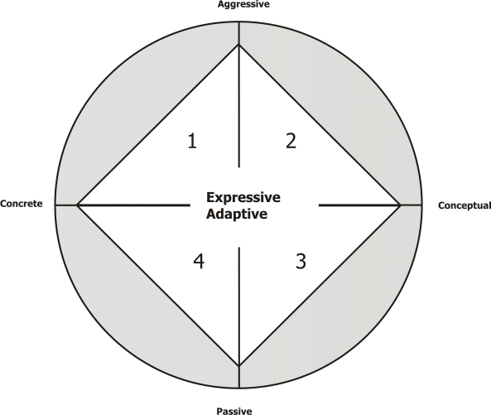To understand the dynamics in a group/team, it is very important to know the communication profiles of the individuals in the group/team. A profile consists of two factors namely communication style and thought pattern.
Communication style - Communication style can range from passive to aggressive, with passive-aggressive in-between.
Thought patterns - There are concrete thinking and conceptual thinking. Concrete thinkers apply linear logic to problem-solving; just give them the facts. Conceptual thinkers thrive on intuition and imagination. They are creative, innovative problem-solvers.
The following diagram shows the different communication profiles:

Communication Profiles
The vertical axis refers to communication styles. Within the diamond, communication style ranges from moderately-expressive at the centre up to a more highly-expressive style – animated, exuberant, or extroverted. From the centre, the degree of expressiveness decreases to a mild-mannered style – less forthright, more reserved, sometimes introspective. People in the upper half, in quadrants 1 and 2, tend to respond quickly and make decisions quickly. They sometimes change just because they are bored. People in the lower half, in quadrants 3 and 4 tend to be more cautious. Before deciding, they deliberate. They prefer the status quo.
Thought patterns appear along the horizontal axis. As the term ‘adaptive’ suggests, someone at the centre can easily adjust their thinking. Moving to the right indicates an increasing degree of conceptual thinking; to the left, the pattern of thinking becomes increasingly concrete.
Extremes occur in the grey circle that surrounds the diamond. Such extremes create conflicts and can disrupt teamwork. On the other hand, a successful team should consist of people in all four quadrants.
Arredondo (2000, p 60-67) has different titles for each profile but she warns against labelling people according to their category. It only provides greater understanding of ourselves and others. With that understanding, we gain ideas of how to adapt our communication when interacting with people. People are adaptable by nature and project different personae in different situations.
Profile 1 = Movers and Shakers
Movers and Shakers are primarily motivated to achieve goals and driven to succeed. They prefer to be in charge. Communication cues are statements like “get to the bottom line”, “get to the point”.
How to communicate with Movers and Shakers: Talk to them about strategies, action plans, progress, accomplishments, and solutions. Be decisive and speak to them in a firm tone of voice. Be assertive if you are a more mild-mannered communicator. Don’t waste their time with trivialities.
Profile 2 = Narrators
People in this category want to tell their story. They are energised by an audience and relish applause. They are self-motivated because they know they cannot always depend on getting it from others. Communication cues from these people are that they are very verbal. They like to elaborate and are colourful and creative.
How to communicate with Narrators: Clearly spell out to them what you need them to do. On occasion you must rein them in when they get carried away. Interject when they pause to breathe and steer them where you want the conversation to go.
Profile 3 = Care Givers
Care givers are ‘people’s people’. Their chief motivation is to serve others. They gain satisfaction from doing something worthy of approval. They speak in terms that convey their desire to please with questions like “Is it OK with you?” or “I am not exactly sure if this is what you want?”
How to communicate with Care Givers: To a care giver, anniversaries and birthdays are very important. Remember to congratulate them. Talk to them as if they are doing you a big favour to do something e.g. “You will be doing me a big favour if...”. Remember to smile when you interact with them.
Profile 4 = Map Makers
Map makers design and develop things for the rest of us to use. They are motivated to figure things out. They are primarily concrete thinkers. They use few words and are task focused. Their vocal and visual cues tend to be restrained, making it difficult to discern what they really think.
How to communicate with Map Makers: Do not rush a map maker. Present material in writing. Map makers want to be well prepared; spontaneity doesn’t suit them. Talk to them about precision, an excellent solution to a problem, exceeding expectations. They love to hear that.